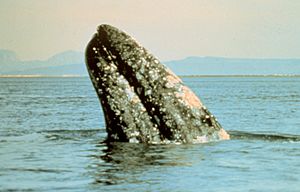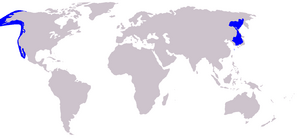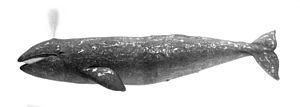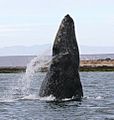Gray whale facts for kids
Quick facts for kids Gray whale |
|
|---|---|
 |
|
| A Gray Whale | |
 |
|
| Size comparison against an average human | |
| Scientific classification | |
| Kingdom: | |
| Phylum: | |
| Class: | |
| Order: | |
| Suborder: | |
| Family: |
Eschrichtiidae
|
| Genus: |
Eschrichtius
|
| Binomial name | |
| Eschrichtius robustus |
|
 |
|
| Gray whale range | |
The gray whale is a type of baleen whale. This means it's a giant sea animal that filters its food from the water. Gray whales have a thick layer of fat called blubber, which can be up to 10 inches (25 cm) thick. This blubber helps them stay warm in cold ocean waters.
Long ago, whalers called the gray whale a devilfish. This was because mother gray whales would fiercely protect their babies. They would even attack whalers and flip over their boats!
Gray whales travel together in groups called pods. Each year, they migrate from cold waters to warmer areas. They are very good swimmers and can dive deep. They can hold their breath for up to 30 minutes and go as deep as 500 feet (155 m). Gray whales also make different sounds like grunts, clicks, and whistles. Scientists think these sounds help them talk to each other.
Contents
What Do Gray Whales Eat?
Gray whales are huge, but they eat tiny things! They find their food on the ocean floor. Their diet includes small fish, crustaceans (like crabs and shrimp), squid, and other tiny creatures.
They have special comb-like plates in their mouths called baleen. When they eat, they scoop up huge amounts of sand and water from the bottom. Then, they use their baleen to sieve, or filter, the food out of the sand and water. It's like using a giant strainer to catch their meal!
How to Identify a Gray Whale
Compared to many other baleen whales, gray whales are not the biggest. They usually grow to be about 45 feet long. They are easy to spot because of their unique gray color, which often looks more like charcoal black with lighter patches.
Gray whales often have many barnacles and small creatures called whale lice living on their skin. You might think these bother the whale, but scientists say they don't cause harm. In fact, these barnacles and lice might even help the whale by eating dead skin that the whale needs to shed.
Did you know that whales can be "left-finned" or "right-finned"? Just like humans are right-handed or left-handed, whales tend to use one side of their body more than the other. You can actually tell which fin a gray whale prefers to use! The fin with fewer barnacles is usually the one it uses more often. This is because when the whale dives down to the ocean floor to scoop up sand for food, the barnacles on the side that rubs along the bottom get scraped off. So, the side with fewer barnacles is the whale's preferred "digging" side!
Where Do Gray Whales Travel?
Gray whales are champions of long-distance travel! They make one of the longest migrations of any mammal on Earth. Each year, they travel about 12,500 miles (20,000 km) round trip.
Their journey takes them from the cold Arctic Ocean (near Alaska) all the way down to the warm coastal lagoons of Mexico in the Pacific Ocean, and then back again. They spend the summer months feeding in the rich, cold waters of the Arctic. Then, when winter comes, they head south to the warm, protected lagoons off Mexico. These lagoons are safe places for them to give birth to their calves and to mate. They usually stay close to the coast during their long trip.
Images for kids
-
Gray whale breaching (jumping out of the water)
-
Gray whale spouting along shores of Yachats
-
A whale swims off the coast near the Santa Monica Mountains.
-
Embryos of gray whale (1874 illustration) and outline of head showing spouthole
-
Gray whale breaching off the coast of Santa Barbara, California
-
A gray whale swims near surf on Nootka Island within residential range.
-
A gray whale in the water off Sakhalin Island.
See also
 In Spanish: Ballena griega para niños
In Spanish: Ballena griega para niños















